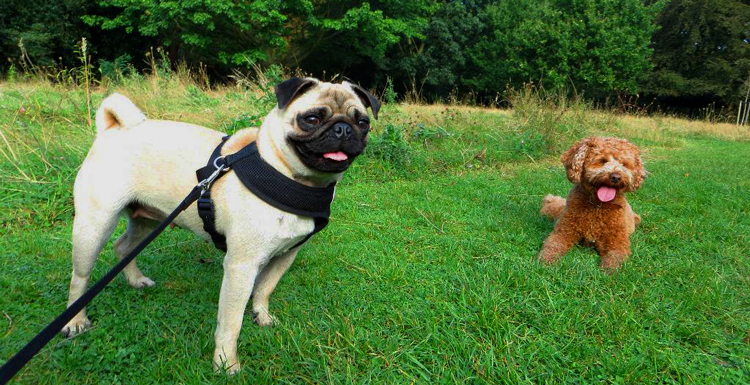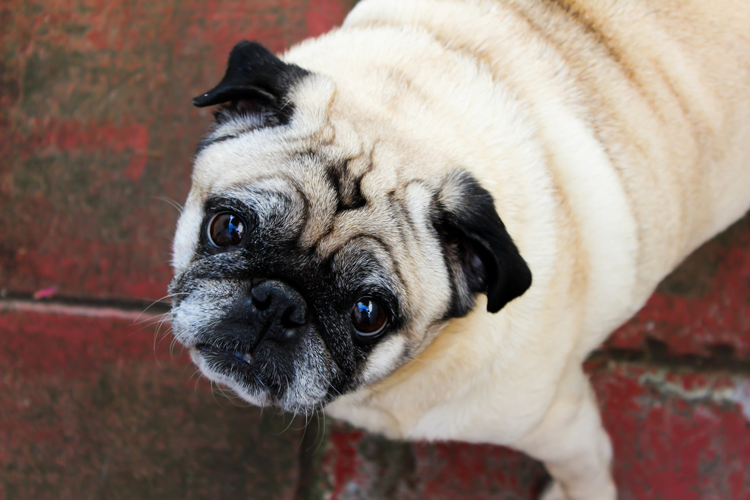Pugs regularly take their place in lists of the top 10 popular dog breeds, and it’s not hard to see why. A compact creature with a soft wrinkly face at one end and a proudly curled tail at the other, the Pug’s iconic look is surpassed only by its charming personality. Nobody is 100% sure about the Pug’s ancestry – but we sure are glad it found its way here! Let’s take a look at the characteristics of the Pug.
Quick Facts:
Breed Group: Toy
Size: Small
Sheds?: Yes
Coat length: Short
Exercise: Up to 30 mins per day
Grooming required?: At least once a week
History
The Pug’s history is a bit of a mystery. They were a favourite pet of Tibet’s Buddhist monks and reportedly one of the first Asian breeds to be miniaturised. Pugs made it to Europe around the turn of the 16th century and quickly won favour with peasants and aristocracy alike. The word ‘Pug’ may be derived from the Latin word ‘pugnus’, meaning ‘clenched fist’. Was there ever a name less suitable for such a well-tempered creature?
Health
Pugs have a long lifespan of 12-15 years.
This breed can suffer from allergies and skin problems, as well as a number of health problems associated with their short muzzle. Breathing problems include wheezing and snoring. They catch colds easily and are uncomfortable in very hot or cold weather. And a Pug’s eyes are bigger than its belly – they will happily overeat, so you’ll need to keep tabs on their diet.
Characteristics
The joyful joker
Pugs are playful, peppy and spirited, while also carrying themselves with a sense of unrivalled dignity. If you choose to own one, prepare to smile and laugh along. Lots.
Fit for apartment living
Pugs don’t fare well in hot or cold weather, they’re relatively inactive indoors, and they don’t need a huge amount of exercise. Their thick, short-haired coat is relatively easy to groom too. This makes them an ideal breed for city dwellers.
Follow the leader
A Pug will instinctively follow a human, so keep yours close to heel when you go for your daily walk. They are strong dogs and need some regular exercise, but beware – they can’t play too hard or fast due to the potential for breathing issues.
Training
On the upside, Pugs are smart and easy to please. On the flipside… as an intelligent and inquisitive breed, they can get bored easily and are adept at spotting weakness in a trainer. Stay shrewd and you’ll make great strides.
Housebreaking
Pugs aren’t the easiest breed to housebreak, especially in the rain. And we’d be lying if we said they weren’t a tad gassy!
Where to find Pugs:
Pug Groups
Interested in meeting and swapping stories with fellow Pug owners? One of these groups might be for you.
Pug Dog Club
Pug Meet Ups in London
Adopt a Pug
Want to adopt a Pug in need of a loving home? Find a rescue centre below.
Pugs.co.uk
The Pug Dog Welfare & Rescue Association
SweetPea Pugs
Breeders
Sold on the Pug’s charm? Here is the list of Kennel Club Assured Breeders
Do you own a Pug?

If you own a Pug, let us know in the comments below and upload your picture to our Facebook, Twitter and Instagram tagging @DogBuddyCo. We’ll add our favourites to this Pug-profile!
Go check out our very own office Pug, Ramon Zepug, and follow him on Facebook!
